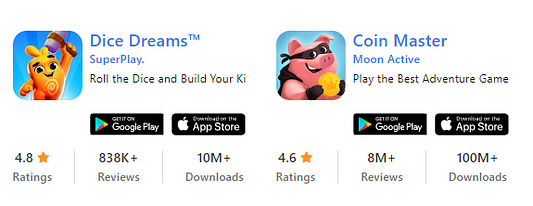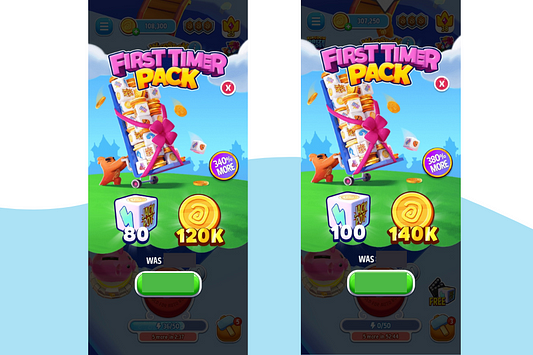How do you compete with a global hit advertised by celebrities like the Kardashians and Cardi B and still become a big success?
The team behind Dice Dreams seems to have the answer.
Dice Dreams is a game clearly inspired by Coin Master. But, it’s not one of its many copycats on the market. This game has plenty of unique features and strong points, from UA to gameplay and monetization.
In our Dice Dreams analysis, we’ll go over all these game aspects in detail.
But for starters, here’s how the game became what it is today.
Dice Dreams — Not An Instant Success
Dice Dreams was launched in October 2019 by SuperPlay. At the time, SuperPlay was a brand-new studio founded by an experienced team.
Despite their experience level, the game didn’t become an overnight success.
It remained in soft launch for about a year.
In this phase, the team was struggling to reach the desired KPIs. However, they had no intention of giving up. They gradually improved one KPI at a time until they got high enough to launch the game internationally.
During the lockdown era, the game’s numbers were solid and steady.

Dice Dreams’ App Store downloads over time. Source: GameRefinery
However, the game reached its first big peak only a year later, in mid-2021. After a slight decline, its downloads peaked again at the start of 2022.
Since then, the game has been going strong.
According to GameRefinery’s iOS data, 66% of Dice Dreams’ downloads come from the US. This was the game’s top market from the start. However, in 2022, we can see a big rise in installs from Europe, especially from the UK and the Netherlands.
The Numbers
Today, Dice Dreams is a successful game with over 10 million Google Play and 2 million App Store downloads.
Sure, this is miles away from Coin Master’s evergreen status.
At the moment, this game has over 170 million downloads and almost $1.6 billion in revenue (Apptica).
Really incredible.
But, this doesn’t mean that Moon Active shouldn’t keep an eye on this rising competitor.
Dice Dreams has been on a growth spurt not only in downloads but also in revenue.
Throughout 2022, the game has held a stable position in the top-grossing charts. According to Apptica, it is currently the 10th top-grossing casual game in the U.S. on Android. Meanwhile, Coin Master is #2.
Finally, there is one aspect where Dice Dreams beats its competitor.

Comparison between Dice Dreams and Coin Master. Source: AppGrooves
This game has a better rating than Coin Master in both app stores. In Google Play, it has a 4.7 rating. In the App Store, the rating is even more impressive — 4.9.
*Last check in December 2022
We all know how important app store reviews are, so this is quite a big deal. These ratings imply that Dice Dreams is a quality, player-oriented game.
Dice Dreams Analysis Part 1: The Basics
We’re not here to discuss numbers only.
What we really want to find out is how this game got to the numbers it has today, and if there’s room for it to grow further.
It’s practically impossible to talk about this game without comparing it to Coin Master, so we’ll be doing that as well.
Let’s begin our Dice Dreams analysis.
Gameplay & Mechanics

Just like the big red “spin” sign is the heart of Coin Mater, a big red “roll” sign is at the core of Dice Dreams.
Both of these are simple, familiar games of luck.
But, the success of this game doesn’t come from the core alone, but also from all the things built around it. Thanks to dice rolling, the players earn coins to build their kingdoms. It also allows them to attack and rob other players.
The players are constantly encouraged to log in to Facebook and play with friends, which makes the game more exciting and competitive.
Main Differences from Coin Master
The premise of Dice Dreams is a lot like Coin Master.
However, it’s the little things that make all the difference. For example, even though both games have “attack” and “steal” modes, they don’t feel too much alike.
Attack Mode

When Dice Dreams players attack a kingdom, they need to choose a building and swipe to catapult their characters to it.
This puts players in control.
If they aim well enough, they can win a “bullseye bonus”. Since the outcome of their attack depends on their skills, this engages players and makes them feel useful.
In Coin Master, the players also choose the building to attack, but there is not much engaging action. In its attack mode, it all comes down to simple tapping.
Steal Mode

The “robbing” mode of Dice Dreams is quite distinct, too. In Coin Master, players need to tap X-marked spots to dig out the treasure.
However, in Dice Dreams, they need to roll a special dice in others’ kingdoms. The more luck they have, the more they will be able to steal from them. This works as an extension of the core game but in a fresh setting.
Dice Dreams Analysis Part 2: UA Strategy
We already mentioned that Dice Dreams had its ups and downs throughout the years.
This had a lot to do with the game’s user acquisition strategy.
In the beginning, the developers didn’t invest huge amounts of money in advertising. At the time, they made sure that they use their tight budgets in the most precise way possible. As the game grew, they started producing more creatives, using broader targeting, etc.
According to SocialPeta, in May 2021, the game was advertised mainly on Facebook, Messenger, Instagram, and the Audience Network.
But then in late 2021, the game’s downloads suddenly dropped.
According to the developers, in more ways than one, this was a marketing choice. At this point, a lot was going on in the market (privacy changes, a flood of competitors, etc.). For this reason, the company took a step back and came up with a new strategy.
Result?
This has led to one of their most important strategic decisions — testing new ad networks. Thanks to diversifying advertising channels, the game managed to reach new heights.
Dice Dreams Analysis Part 3: Monetization & Retention
Players are quick to punish greedy games with bad app store ratings.
Therefore, for a game to get such great ratings as Dice Dreams, it needs to have a good monetization strategy.
And of course, there’s no monetization without retaining players first.
Here’s how Dice Dreams handles both of these.
In-App Purchases
Just like most casual games, Dice Dreams offers in-app purchases.
In the game’s store, players can find two things to purchase — rolls and coins. They both come in six different-sized packs. The prices of rolls range from $1.99 to $99.99. Coins are more of a luxury item, with prices from $4.99 to $99.
What sells best?
None of this.
Dice Dreams players react better to time-limited, cheaper offers. According to Sensor Tower, the game’s top two in-app purchases are one-time offers at $1.99.
How does this compare to Coin Master’s offerings?
It is very similar — this game offers spin and coin packs ranging from $1.99 to $99.99. However, some of its special offers are even cheaper. The game’s two best-selling IAPs are $0.99 one-time offers.
Special IAP Offers
The first special offer Dice Dreams players get is a “First Timer Pack” at $1.99. This offer comes at a huge discount of 340%. This is a tried-and-true strategy to convert new players with great value for money.
For undecisive players, the game has a special strategy.

The offer remains valid for days. As players play some more, its price remains the same, while offerings increase. While non-interested players probably won’t even notice, this can make unsure players finally convert.
This is another strategy Dice Dreams developers “borrowed” from Coin Master, and we don’t blame them at all. It’s a good one.
But, that’s not all there is.
Dice Dreams uses another smart, but sneaky strategy to “push” the First Timer Pack.

After being offered for a while, another special offer appears along with it. It pops up right after it, and comes at the same cost, but it’s not nearly as valuable. The thing is, this offer acts like a decoy to push players into realizing the value of the first one.
We haven’t seen anything like this in Coin Master.
Social vs. IAPs
Dice Dreams is even more focused on social features than its competitor.
Here’s what we mean by that.

When players use all of the rolls, they don’t get an IAP pop-up first. Instead, they first get a pop-up asking them to invite their friends to the game.
Only after that, they are served with an IAP offer.
In Coin Master, the sequence is reversed. IAPs are the number one priority, while social is second.
Why do they do this?
Well first, the game really is much more fun when playing with friends than with random strangers. Second, it brings in new players cost-free. Third, a lot of players would rather do this instead of making in-app purchases.
Rewarded Video Ads
Dice Dreams doesn’t neglect its non-spending players. This is another reason why the game has such good ratings.
If they run out of rolls, players don’t have to buy them.
They don’t have to wait for new ones either.

Instead, they can always win them for free by watching rewarded video ads. Early in the game, players will stumble upon these two ad placements:
- “Free rolls” next to the roll button. Appears automatically when players have less than 10 rolls left and brings 2 extra rolls.
- “Free rolls” in the game’s features. Placed next to the game’s shop, social and other features. It also grants 2 additional rolls when players have less than 10.
Unlike this game, Coin Master displays no ads whatsoever — it is all about IAPs. But who knows, maybe this will change if inflation continues decreasing the players’ purchasing power.
Main Retention Strategies
Retention rates tell you a lot.
If they are good, this means your UA campaigns targeted the right people, that they like your game, and they can become valuable to it.
Retention has a lot to do with the gameplay itself, but there is much more to it. There are different methods developers can use to keep players excited about their games.
Here are the main retention strategies SuperPlay uses in Dice Dreams:
- Social media connection
- Missions
- Leaderboard
- Push notifications
- Card collection
- Kingdom news
- Surprise rewards
Dice Dreams Analysis Wrap Up
At the end of this Dice Dreams analysis, you may be wondering — who plays this game?
We believe that this game has two key groups of players.
The first one is players who have never played Coin Master and only discovered this tried-and-true game concept. The second group is people who actively played it, but weren’t happy with the game’s focus on IAPs.
What is your opinion on this and the game in general?
Don’t hesitate to leave us a comment. Also, make sure to subscribe to our newsletter!







